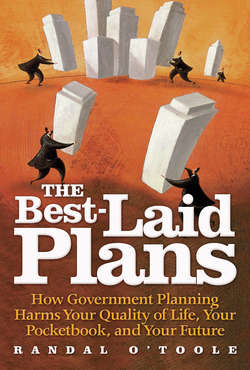Читать книгу The Best-Laid Plans - Randal O'Toole - Страница 17
На сайте Литреса книга снята с продажи.
Part Two Why Planning Fails
ОглавлениеIt is a popular delusion that the government wastes vast amounts of money through inefficiency and sloth. Enormous effort and planning are required to waste this much money.
—P. J. O’Rourke1
Because they can grow a tree, planners think they can plan a million-acre forest. Because they can build a house, planners think they can design an entire urban area. But there is a qualitative difference between these activities that is more than just a matter of scale. Ecosystems and cities are complex systems that are inherently unpredictable, even chaotic. This term is used in the sense of chaos theory, best known for the aphorism, “A butterfly stirring the air today in Beijing can transform storm systems in New York next month.”2 Since even the near-term future of chaotic systems cannot be accurately foreseen, any attempt to plan the distant future will fail.
Any who say they can write a comprehensive, long-range plan for a city or region necessarily presumes that
• they can collect all the data they need about the values and costs of the land, improvements, and proposed and alternative projects in the planning area;
• they can accurately predict how those values and costs will change in the future;
• they can properly understand all the relationships between various parts of their region and activities in those areas;
• they can do all this quickly enough that the plan is still meaningful when they are done; and
• they will be immune to political pressures and can objectively overcome their own personal preferences.
Consider an urban area with a million people and a million parcels of property, each of which could be used for dozens of different purposes. Each of those people places a different value on each potential use of each parcel of land, resulting in trillions of different pieces of data to collect. Add transportation and other infrastructure (each item of which will be separately valued by each of the million people), changes in tastes and trends over time, and the way different uses on different properties influence the values of other nearby properties, and the data requirements reach into the quadrillions. No one can ever collect or understand this much data.
What do scientific, rational planners do when confronted with problems of this magnitude? They simplify.
• Instead of comprehensively planning for all resources, they focus on one or two resources.
• Instead of measuring the actual relationships between resources, they rely on preconceived notions and the latest planning fads.
• Instead of predicting the future, they envision what they want and try to impose that vision on the future.
• Instead of finding out what the people in the region really want, they succumb to pressures from powerful interest groups.
In The Death and Life of Great American Cities, Jane Jacobs called planning a “pseudoscience.”3 That remains true today not because of any flaws in the planners but because the promises planners make are simply impossible to keep. As a result, plans end up doing far more harm than good to the cities and regions for which they are written.
